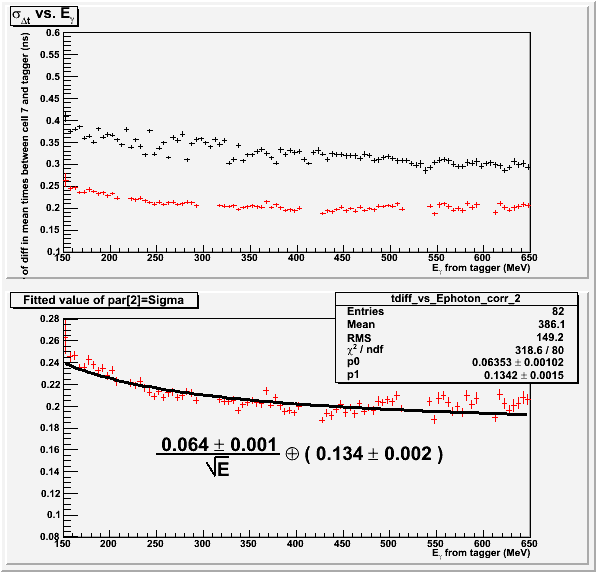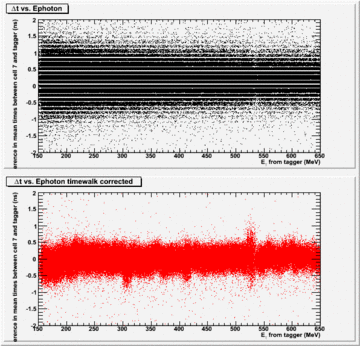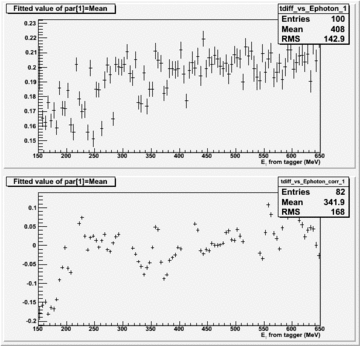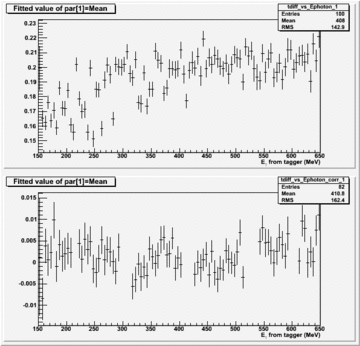BCal Beam Test Plots, May 8, 2007
Contents
Energy Weighting
The timing resolution of the BCal should improve when one begins to group the individual cells into a cluster of cells. Ideally one would like to weight each cell by its own resolution (i.e. multiply by the inverse squared) such that cells with a poorer resolution contribute less to the overall resolution. However, one also needs to know the resolution for each cell to a good degree otherwise the cells which truly have a lower resolution might end up contributing more than they should giving one a worse resolution overall as a result. The next best thing would be to weight each cell by its deposited energy which is directly measured. The ADC signal is proportional to the energy deposit by some calibration constant. The inverse square of the resolution of the cell is also proportional to the energy deposited. Hence, we define the time at each calorimeter end to be
and the average of TN and TS defines the mean time. Each end of the cell should have identical responses and we can assume EN = ES. For the case where the beam is at dead center of the module the ADC signals should also be similar except for some gain correction factors. We can then define the mean time and time difference as
 and
and
respectively. We estimate the contribution to the resolution from jitter in the Master OR signal from the Tagger to be σtagger = 113 ps which has been subtracted in quadrature from the constant term of the fit of the mean time resolution to obtain the correct mean time resolution. ΔT and T are the difference and sum of TN and TS and therefore the distributions have the same rms. spread. One therefore expects σT = σΔT.
Currently I am only including cells 7,8,9 and 10 in the cluster and then only if cells 7 and 8 have a deposited energy exceeding ~4 MeV and cells 9 and 10 must exceed ~1.5 MeV.
Mean Time Resolution σT
The bottom left image is the distribution before walk correction (black) and after walk correction (red). The bottom right image are the means of the left two plots. Notice the large fluctuations even after walk corrections. 3 or 4 of the largest "spikes" are presumably from a pmt being dead on one side of a t-counter. The first large spike is from the overlap of 2 different sized t-counters.
Time Difference Resolution σΔT
The bottom left image is the distribution before walk correction (black) and after walk correction (red). The bottom right image are the means of the left two plots. Notice that there are little or no fluctuations now that the tagger is not involved as can be seen in the bottom plots of both bottom images. The fit for the resolution is greatly improved compared to the fit of the mean time resolution.
Number of Photoelectrons
A. Antonelli et al. / Nucl. Intr. and Meth. in Phys. Res. A 354 (1995) 352-363
"The fluctuation of the ratio R between the energy signals, from each readout element, EA and EB at the two calorimter end, R = EA/EB, allows us to estimate the number of photoelectrons Npe/PM. Under the assumption that quantum efficiencies and optical couplings are the same for both ends, and neglecting any correlation between EA and EB, we obtain
 , μR and σR are the mean of R and the rms spread of its distribution repectively."
, μR and σR are the mean of R and the rms spread of its distribution repectively."
KLOE ~ 5000 pe/GeV
GlueX ~ 6500 pe/GeV (summing the pe of each pmt) -the increase is entirely due to the larger capture ratio of the double clad fibres used in GlueX where only single clad were used in KLOE. (approximately 600 pe are detected 2m away at 525 MeV on one end)








